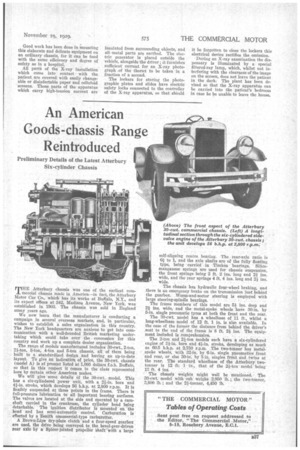An American Goods-chassis Range Reintroduced
Page 71

If you've noticed an error in this article please click here to report it so we can fix it.
MITE Atterbury chassis was one of the earliest com mercial chassis made in America—in fact, the Atterbury Motor Car Co:, which has its works at Buffalo, N.Y., and its export offices at 342, Madison Avenue, New York, was established in 1903. The chassis was sold in England niany years ago.
We now learn that the manufacturer is conducting a campaign in several overseas markets, and, in particular, wishes to establish a sales organization in this country. The New York headquarters are anxious to get into communication with a well-founded British marketing undertaking which could take over the concession for this country and work up a complete dealer organization.
The range of models manufactured includes 30-cwt., 2-ton, 21-ton, 3-ton, 4-ton and 5-ton chassis, all of them being built to a standardized design and having an 0-to-date layout. To give an indicaticin of price, the 30-cwt chassis (model A) is at present listed at 1,095 dollars f.o.b. Buffalo, so that in this respect it comes in the class represented here by certain other American makes. '
We will give some details of the 30-cwt. model. This has a six-cylindered power• unit, with a 21-in. bore and 41-in, stroke, which develops 56 b.h.p. at 2,800 r.p.m. It is flexibly suspended at three points in the frame. There is full-pressure lubrication to all important bearing surfaces. The valves are located at the side and operated by a Camshaft carried in the crankcase, the cylinder head being detachable. The ignition distributor is Mounted 'on the head and has semi automatic control. ' Carburation is efected by a Zenith commercial type carburetter.
A Brestai-Lipe dry plate clutch and a four-speed.gearbox are used the drive being conveyed to the bevel-gear-driven rear amie by a Spicer-jointed propeller haft-with' a large
self-aligning centre bearing. The rear-axle ratio is 61 to 1, and the axle shafts are of the fully floating type, being carried in Timken bearings. Silicomanganese springs are used for chassis suspension, the front springs being 3 ft. 2 ins, long and 24 ins. wide, and the rear springs 4 ft. 4 ins, long and 21 ins. wide.
• The chassis has hydraulic four-wheel braking, and there is an emergency brake on the transmission just behind the gearbox. Worm-and-sector steering is employed with large steering-spindle bearings. '
The frame members of this model are 51 ins, deep and 21 ins, wide, and the metal-spoke wheels have 30-in. by 5-in, single pneumatic tyres at both the front and the rear.
The 30-cwt. model has a wheelbase of 11 ft., whilst a long-wheelbase model of 12 ft. 1 in. is also available. In the case of the former the distance from behind the driver's seat to the end of the frame is 8 ft. 24 ins. The equip ment included is comprehensive.
The 2-ton and 21-ton models each have a six-cylindered ' engine of 31-in. bore and 41-in. stroke, developing as much as 60.5 b.h.p. at 2,750 r.p.m. The two-tonner has metalspoke wheels, with 32-in. by 6-in single pneumatics front and rear, or else 30-in. by 5-in. singles front and twins at the rear. The standard wheelbase of the Atterbury twotanner is 12 ft. 1 in., that of the 21-ton model being 1.3 ft. 4 ind.
The chassis weights might well be mentioned. The 30-cwt. model with cab weighs 2,950 lb.; the two-tonner, 3,800 lb.; and the 21-tonner, 4,450 lb.




















































































































